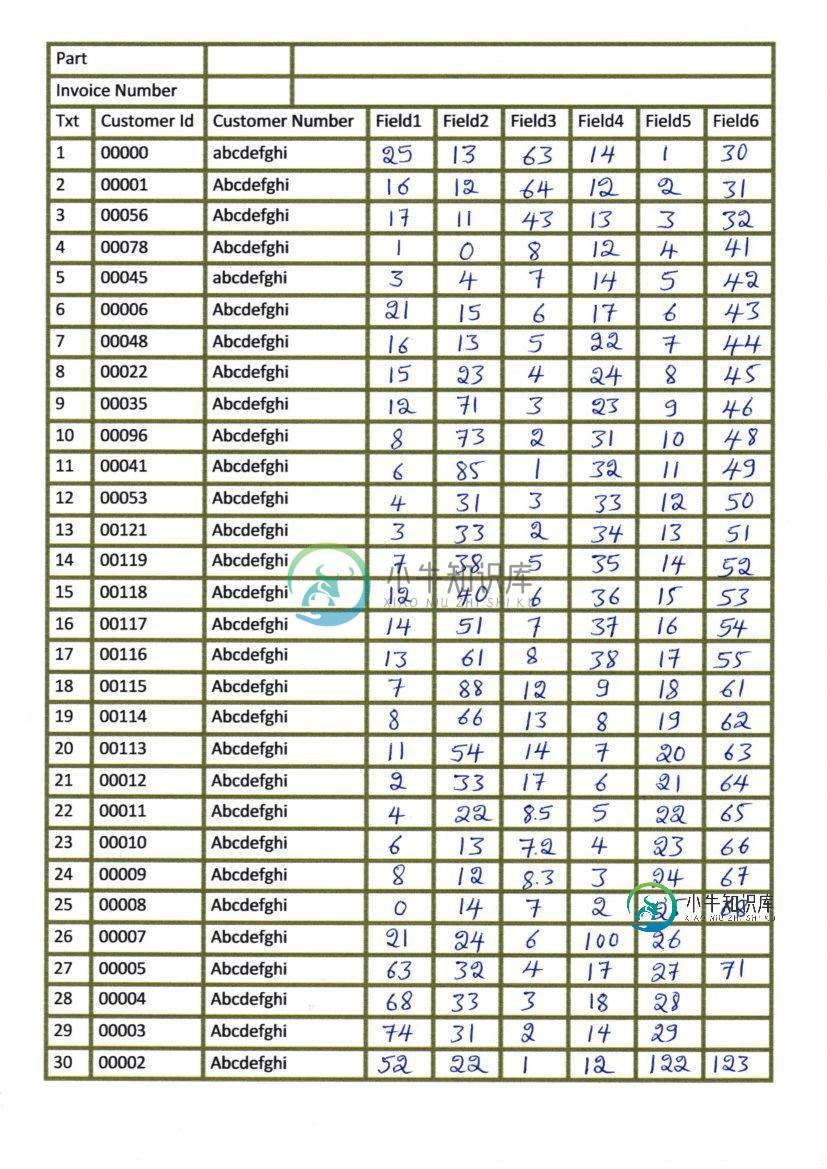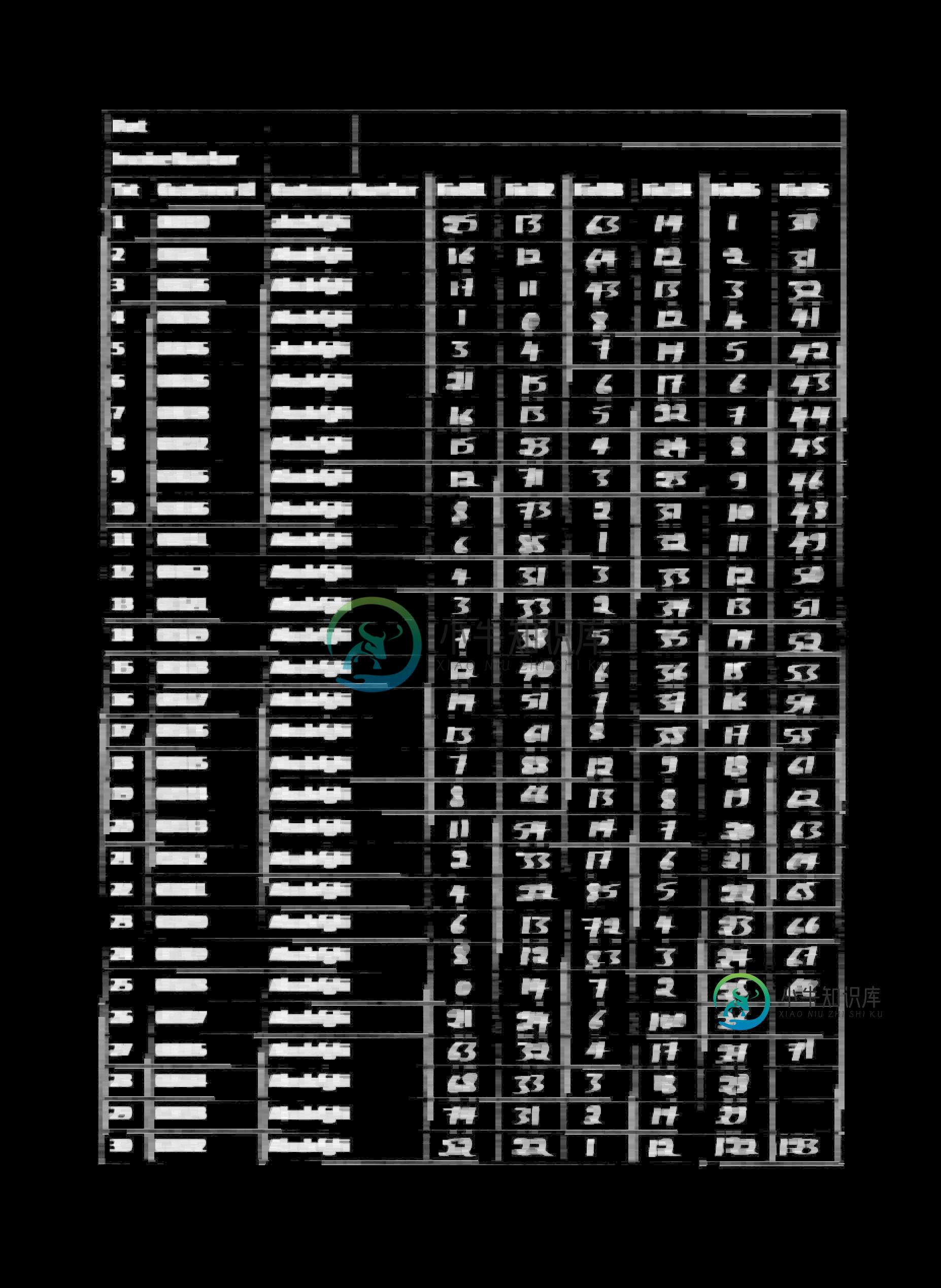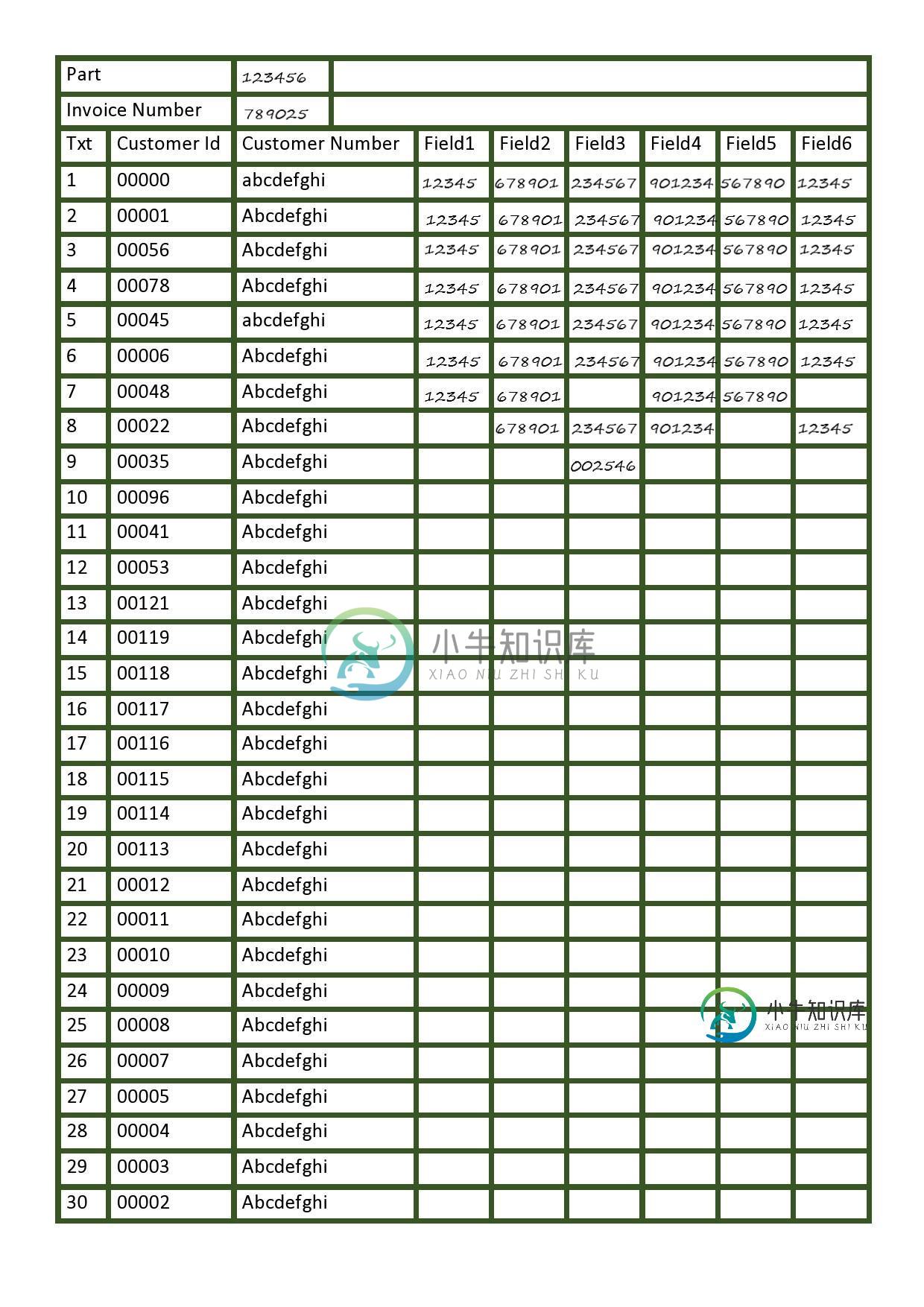使用OCR将表格图像中的单个字段提取到excel
我扫描了一些图像,这些图像有如下所示的表格:

我试图分别提取每个框并执行OCR,但当我尝试检测水平线和垂直线,然后检测框时,它会返回以下图像:

当我尝试执行其他转换来检测文本(侵蚀和扩张)时,一些残留的线条仍然伴随着文本出现,如下所示:

我不能检测文本只执行OCR和正确的边界框不会生成如下所示:

我不能使用真正的线条清晰地分开盒子,我已经在一个用油漆编辑的图像上尝试过了(如下所示),以添加数字,并且它是有效的。

我不知道哪一部分我做错了,但如果有什么我应该尝试或可能改变/添加我的问题,请告诉我。
#Loading all required libraries
%pylab inline
import cv2
import numpy as np
import pandas as pd
import pytesseract
import matplotlib.pyplot as plt
import statistics
from time import sleep
import random
img = cv2.imread('images/scan1.jpg',0)
# for adding border to an image
img1= cv2.copyMakeBorder(img,50,50,50,50,cv2.BORDER_CONSTANT,value=[255,255])
# Thresholding the image
(thresh, th3) = cv2.threshold(img1, 255, 255,cv2.THRESH_BINARY|cv2.THRESH_OTSU)
# to flip image pixel values
th3 = 255-th3
# initialize kernels for table boundaries detections
if(th3.shape[0]<1000):
ver = np.array([[1],
[1],
[1],
[1],
[1],
[1],
[1]])
hor = np.array([[1,1,1,1,1,1]])
else:
ver = np.array([[1],
[1],
[1],
[1],
[1],
[1],
[1],
[1],
[1],
[1],
[1],
[1],
[1],
[1],
[1],
[1],
[1],
[1],
[1]])
hor = np.array([[1,1,1,1,1,1,1,1,1,1,1,1,1,1,1]])
# to detect vertical lines of table borders
img_temp1 = cv2.erode(th3, ver, iterations=3)
verticle_lines_img = cv2.dilate(img_temp1, ver, iterations=3)
# to detect horizontal lines of table borders
img_hor = cv2.erode(th3, hor, iterations=3)
hor_lines_img = cv2.dilate(img_hor, hor, iterations=4)
# adding horizontal and vertical lines
hor_ver = cv2.add(hor_lines_img,verticle_lines_img)
hor_ver = 255-hor_ver
# subtracting table borders from image
temp = cv2.subtract(th3,hor_ver)
temp = 255-temp
#Doing xor operation for erasing table boundaries
tt = cv2.bitwise_xor(img1,temp)
iii = cv2.bitwise_not(tt)
tt1=iii.copy()
#kernel initialization
ver1 = np.array([[1,1],
[1,1],
[1,1],
[1,1],
[1,1],
[1,1],
[1,1],
[1,1],
[1,1]])
hor1 = np.array([[1,1,1,1,1,1,1,1,1,1],
[1,1,1,1,1,1,1,1,1,1]])
#morphological operation
temp1 = cv2.erode(tt1, ver1, iterations=2)
verticle_lines_img1 = cv2.dilate(temp1, ver1, iterations=1)
temp12 = cv2.erode(tt1, hor1, iterations=1)
hor_lines_img2 = cv2.dilate(temp12, hor1, iterations=1)
# doing or operation for detecting only text part and removing rest all
hor_ver = cv2.add(hor_lines_img2,verticle_lines_img1)
dim1 = (hor_ver.shape[1],hor_ver.shape[0])
dim = (hor_ver.shape[1]*2,hor_ver.shape[0]*2)
# resizing image to its double size to increase the text size
resized = cv2.resize(hor_ver, dim, interpolation = cv2.INTER_AREA)
#bitwise not operation for fliping the pixel values so as to apply morphological operation such as dilation and erode
want = cv2.bitwise_not(resized)
if(want.shape[0]<1000):
kernel1 = np.array([[1,1,1]])
kernel2 = np.array([[1,1],
[1,1]])
kernel3 = np.array([[1,0,1],[0,1,0],
[1,0,1]])
else:
kernel1 = np.array([[1,1,1,1,1,1]])
kernel2 = np.array([[1,1,1,1,1],
[1,1,1,1,1],
[1,1,1,1,1],
[1,1,1,1,1]])
tt1 = cv2.dilate(want,kernel1,iterations=2)
# getting image back to its original size
resized1 = cv2.resize(tt1, dim1, interpolation = cv2.INTER_AREA)
# Find contours for image, which will detect all the boxes
contours1, hierarchy1 = cv2.findContours(resized1, cv2.RETR_TREE, cv2.CHAIN_APPROX_SIMPLE)
#function to sort contours by its x-axis (top to bottom)
def sort_contours(cnts, method="left-to-right"):
# initialize the reverse flag and sort index
reverse = False
i = 0
# handle if we need to sort in reverse
if method == "right-to-left" or method == "bottom-to-top":
reverse = True
# handle if we are sorting against the y-coordinate rather than
# the x-coordinate of the bounding box
if method == "top-to-bottom" or method == "bottom-to-top":
i = 1
# construct the list of bounding boxes and sort them from top to
# bottom
boundingBoxes = [cv2.boundingRect(c) for c in cnts]
(cnts, boundingBoxes) = zip(*sorted(zip(cnts, boundingBoxes),
key=lambda b:b[1][i], reverse=reverse))
# return the list of sorted contours and bounding boxes
return (cnts, boundingBoxes)
#sorting contours by calling fuction
(cnts, boundingBoxes) = sort_contours(contours1, method="top-to-bottom")
#storing value of all bouding box height
heightlist=[]
for i in range(len(boundingBoxes)):
heightlist.append(boundingBoxes[i][3])
#sorting height values
heightlist.sort()
sportion = int(.5*len(heightlist))
eportion = int(0.05*len(heightlist))
#taking 50% to 95% values of heights and calculate their mean
#this will neglect small bounding box which are basically noise
try:
medianheight = statistics.mean(heightlist[-sportion:-eportion])
except:
medianheight = statistics.mean(heightlist[-sportion:-2])
#keeping bounding box which are having height more then 70% of the mean height and deleting all those value where
# ratio of width to height is less then 0.9
box =[]
imag = iii.copy()
for i in range(len(cnts)):
cnt = cnts[i]
x,y,w,h = cv2.boundingRect(cnt)
if(h>=.7*medianheight and w/h > 0.9):
image = cv2.rectangle(imag,(x+4,y-2),(x+w-5,y+h),(0,255,0),1)
box.append([x,y,w,h])
# to show image
###Now we have badly detected boxes image as shown
共有3个答案
这是一个使用tesseract ocr进行版面检测的函数。您可以尝试使用不同的RIL级别和PSM。有关更多详细信息,请查看此处:https://github.com/sirfz/tesserocr
import os
import platform
from typing import List, Tuple
from tesserocr import PyTessBaseAPI, iterate_level, RIL
system = platform.system()
if system == 'Linux':
tessdata_folder_default = ''
elif system == 'Windows':
tessdata_folder_default = r'C:\Program Files (x86)\Tesseract-OCR\tessdata'
else:
raise NotImplementedError
# this tesseract specific env variable takes precedence for tessdata folder location selection
# especially important for windows, as we don't know if we're running 32 or 64bit tesseract
tessdata_folder = os.getenv('TESSDATA_PREFIX', tessdata_folder_default)
def get_layout_boxes(input_image, # PIL image object
level: RIL,
include_text: bool,
include_boxes: bool,
language: str,
psm: int,
tessdata_path='') -> List[Tuple]:
"""
Get image components coordinates. It will return also text if include_text is True.
:param input_image: input PIL image
:param level: page iterator level, please see "RIL" enum
:param include_text: if True return boxes texts
:param include_boxes: if True return boxes coordinates
:param language: language for OCR
:param psm: page segmentation mode, by default it is PSM.AUTO which is 3
:param tessdata_path: the path to the tessdata folder
:return: list of tuples: [((x1, y1, x2, y2), text)), ...]
"""
assert any((include_text, include_boxes)), (
'Both include_text and include_boxes can not be False.')
if not tessdata_path:
tessdata_path = tessdata_folder
try:
with PyTessBaseAPI(path=tessdata_path, lang=language) as api:
api.SetImage(input_image)
api.SetPageSegMode(psm)
api.Recognize()
page_iterator = api.GetIterator()
data = []
for pi in iterate_level(page_iterator, level):
bounding_box = pi.BoundingBox(level)
if bounding_box is not None:
text = pi.GetUTF8Text(level) if include_text else None
box = bounding_box if include_boxes else None
data.append((box, text))
return data
except RuntimeError:
print('Please specify correct path to tessdata.')
nanthancy的答案也很准确,我使用下面的脚本获取每个框,并按列和行对其进行排序。
注意:大部分代码来自Kanan Vyas的一个中型博客:https://medium.com/coinmonks/a-box-detection-algorithm-for-any-image-containing-boxes-756c15d7ed26
#most of this code is take from blog by Kanan Vyas here:
#https://medium.com/coinmonks/a-box-detection-algorithm-for-any-image-containing-boxes-756c15d7ed26
import cv2
import numpy as np
img = cv2.imread('images/scan2.jpg',0)
#fn to show np images with cv2 and close on any key press
def imshow(img, label='default'):
cv2.imshow(label, img)
cv2.waitKey(0)
cv2.destroyAllWindows()
# Thresholding the image
(thresh, img_bin) = cv2.threshold(img, 250, 255,cv2.THRESH_BINARY|cv2.THRESH_OTSU)
#inverting the image
img_bin = 255-img_bin
# Defining a kernel length
kernel_length = np.array(img).shape[1]//80
# A verticle kernel of (1 X kernel_length), which will detect all the verticle lines from the image.
verticle_kernel = cv2.getStructuringElement(cv2.MORPH_RECT, (1, kernel_length))# A horizontal kernel of (kernel_length X 1), which will help to detect all the horizontal line from the image.
hori_kernel = cv2.getStructuringElement(cv2.MORPH_RECT, (kernel_length, 1))# A kernel of (3 X 3) ones.
kernel = cv2.getStructuringElement(cv2.MORPH_RECT, (3, 3))
# Morphological operation to detect vertical lines from an image
img_temp1 = cv2.erode(img_bin, verticle_kernel, iterations=3)
verticle_lines_img = cv2.dilate(img_temp1, verticle_kernel, iterations=3)
#cv2.imwrite("verticle_lines.jpg",verticle_lines_img)
# Morphological operation to detect horizontal lines from an image
img_temp2 = cv2.erode(img_bin, hori_kernel, iterations=3)
horizontal_lines_img = cv2.dilate(img_temp2, hori_kernel, iterations=3)
#cv2.imwrite("horizontal_lines.jpg",horizontal_lines_img)
# Weighting parameters, this will decide the quantity of an image to be added to make a new image.
alpha = 0.5
beta = 1.0 - alpha# This function helps to add two image with specific weight parameter to get a third image as summation of two image.
img_final_bin = cv2.addWeighted(verticle_lines_img, alpha, horizontal_lines_img, beta, 0.0)
img_final_bin = cv2.erode(~img_final_bin, kernel, iterations=2)
(thresh, img_final_bin) = cv2.threshold(img_final_bin, 128,255, cv2.THRESH_BINARY | cv2.THRESH_OTSU)
cv2.imwrite("img_final_bin.jpg",img_final_bin)
# Find contours for image, which will detect all the boxes
contours, hierarchy = cv2.findContours(img_final_bin, cv2.RETR_TREE, cv2.CHAIN_APPROX_SIMPLE)
""" this section saves each extracted box as a seperate image.
idx = 0
for c in contours:
# Returns the location and width,height for every contour
x, y, w, h = cv2.boundingRect(c)
#only selecting boxes within certain width height range
if (w > 10 and h > 15 and h < 50):
idx += 1
new_img = img[y:y+h, x:x+w]
#cv2.imwrite("kanan/1/"+ "{}-{}-{}-{}".format(x, y, w, h) + '.jpg', new_img)
"""
#get set of all y-coordinates to sort boxes row wise
def getsety(boxes):
ally = []
for b in boxes:
ally.append(b[1])
ally = set(ally)
ally = sorted(ally)
return ally
#sort boxes by y in certain range, because if image is tilted than same row boxes
#could have different Ys but within certain range
def sort_boxes(boxes, y, row_column):
l = []
for b in boxes:
if (b[2] > 10 and b[3] > 15 and b[3] < 50):
if b[1] >= y - 7 and b[1] <= y + 7:
l.append(b)
if l in row_column:
return row_column
else:
row_column.append(l)
return row_column
#sort each row using X of each box to sort it column wise
def sortrows(rc):
new_rc = []
for row in rc:
r_new = sorted(row, key = lambda cell: cell[0])
new_rc.append(r_new)
return new_rc
row_column = []
for i in getsety(boundingBoxes):
row_column = sort_boxes(boundingBoxes, i, row_column)
row_column = [i for i in row_column if i != []]
#final np array with sorted boxes from top left to bottom right
row_column = sortrows(row_column)
我在木星笔记本上做了这个,并复制粘贴在这里,如果出现任何错误,让我知道。
谢谢大家的回答
你走在正确的轨道上。这是你的方法的延续,略有修改。想法是:
>
删除所有字符文本轮廓。我们创建一个矩形内核,并执行打开操作,只保留水平/垂直线条。这将有效地使文本变成微小的噪声,因此我们找到轮廓并使用轮廓区域过滤来删除它们。
修复水平/垂直线并提取每个ROI。我们变形接近于修复和断开的线条,并使桌子平滑。从这里,我们使用imutils对长方体场轮廓进行排序。使用自上而下参数对轮廓进行排序()。接下来,我们找到轮廓并使用轮廓区域进行过滤,然后提取每个ROI。
下面是每个框字段和提取的ROI的可视化
代码
import cv2
import numpy as np
from imutils import contours
# Load image, grayscale, Otsu's threshold
image = cv2.imread('1.jpg')
original = image.copy()
gray = cv2.cvtColor(image, cv2.COLOR_BGR2GRAY)
thresh = cv2.threshold(gray, 0, 255, cv2.THRESH_BINARY_INV + cv2.THRESH_OTSU)[1]
# Remove text characters with morph open and contour filtering
kernel = cv2.getStructuringElement(cv2.MORPH_RECT, (3,3))
opening = cv2.morphologyEx(thresh, cv2.MORPH_OPEN, kernel, iterations=1)
cnts = cv2.findContours(opening, cv2.RETR_TREE, cv2.CHAIN_APPROX_SIMPLE)
cnts = cnts[0] if len(cnts) == 2 else cnts[1]
for c in cnts:
area = cv2.contourArea(c)
if area < 500:
cv2.drawContours(opening, [c], -1, (0,0,0), -1)
# Repair table lines, sort contours, and extract ROI
close = 255 - cv2.morphologyEx(opening, cv2.MORPH_CLOSE, kernel, iterations=1)
cnts = cv2.findContours(close, cv2.RETR_TREE, cv2.CHAIN_APPROX_SIMPLE)
cnts = cnts[0] if len(cnts) == 2 else cnts[1]
(cnts, _) = contours.sort_contours(cnts, method="top-to-bottom")
for c in cnts:
area = cv2.contourArea(c)
if area < 25000:
x,y,w,h = cv2.boundingRect(c)
cv2.rectangle(image, (x, y), (x + w, y + h), (36,255,12), -1)
ROI = original[y:y+h, x:x+w]
# Visualization
cv2.imshow('image', image)
cv2.imshow('ROI', ROI)
cv2.waitKey(20)
cv2.imshow('opening', opening)
cv2.imshow('close', close)
cv2.imshow('image', image)
cv2.waitKey()
-
我只是从图像中提取文本,但当我试图处理表单时,由于表单边界,该程序无法用于字符提取。如何从包含边界的表单中提取字符?
-
我的目标是使用基于OCR服务器的解决方案,以键值格式从护照图像中提取数据,以便数据保留在本地。我尝试了Azure表单识别器容器(认知服务表单识别器API V1预览版)。但结果并不令人满意,因为根据训练数据创建的模型无法提取任何键值对。我尝试了各种训练样本数据,也参考了https://docs.microsoft.com/en-us/azure/cognitive-services/form-rec
-
我正在尝试从图像中提取文本。目前我得到的输出是空字符串。以下是我的pytesseract代码,尽管我也对Keras OCR持开放态度:- 我不确定如何使用svg图像,所以我将它们转换为png。下面是一些示例图像:- 编辑1 (2021-05-19):我可以使用cairosvg将svg转换为png。仍然无法读取验证码文本 编辑2(2021-05-20):Keras OCR也不会为这些图像返回任何内容
-
我想提取只有蓝色文本图像uisng tesseract ocr.请帮助我关于这一点。 我试过的基本代码: 导入PIL. Image导入cv导入pytesseract, remy_image=PIL. Image.open(r"C:\User\sony\Desktop\Cap_sample\MicrosoftTeams-Image(4). png")pytesseract.pytesseract.t
-
我想上传两个或更多的图片,使用一个表单在不同的领域到数据库使用Codeigniter。 但是这里只有一个正在上传...有人能帮我吗... 我的控制器 这是我的模型 这是我的看法 我的数据库 请帮我上传到单独的数据库字段作为两个单独的文件

